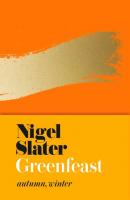Greenfeast. Nigel Slater
Чтение книги онлайн.

Читать онлайн книгу Greenfeast - Nigel Slater страница 5
Название: Greenfeast
Автор: Nigel Slater
Издательство: HarperCollins
Жанр: Кулинария
isbn: 9780008218171
isbn:
Transfer the roasted vegetables and aromatics to a deep saucepan, add the shiitake, rosemary, thyme, bay, peppercorns and the sheets of kombu, then pour a little of the reserved water into the roasting tin, scrape at the sticky, caramelised bits stuck to the tin, then pour into the saucepan. Add the remaining water. Bring to the boil, then lower the heat and leave to simmer, partially covered with a lid, for fifty minutes to an hour.
When you have a deep brown, richly coloured broth, tip through a sieve into a heatproof bowl or large jug and leave to cool. Refrigerate and use as necessary.
• Keeps for up to one week in the fridge.
OATS, DRIED MULBERRIES, DATE SYRUP
The solace of porridge. The sweetness of dried fruits.
Serves 2
porridge oats 100g
dried mulberries 50g
golden sultanas 75g
cream or crème fraîche 4 tablespoons
date syrup 2 tablespoons
Put the oats and 400ml of water into a small saucepan and bring them to the boil. Add a good pinch of salt and stir the oats continuously for four or five minutes with a wooden spoon until the porridge is thick and creamy.
Divide between two bowls, then add the dried mulberries and golden sultanas. Add spoonfuls of crème fraîche, then trickle over the date syrup.
• I often use dried apricots in place of the mulberries, but cranberries and dried cherries are good alternatives.
• The sweetness of the date syrup can be balanced by a spoon or two of stewed tart apples.
On a winter’s evening, I warm butter and olive oil in a shallow-sided, cast-iron pan, turn the heat down low and use it to fry thin slices of potato, Jerusalem artichoke or fennel. Vegetables that will crisp or soften as you wish, and to which I can add other ingredients at will – sweet black grapes and whole parsley leaves to the crisp artichokes; peas and salty cheese to the softened fennel. I do the same with slices of pumpkin or butternut squash, then introduce feta or breadcrumbs or perhaps a fried egg whose yolk will double as an impromptu sauce.
A heavy frying pan in which you can leave things to cook at a moderate temperature is worth its weight in gold. It is the gift I would give to a kid leaving home. The possibilities are endless. Mushrooms, sliced and sautéed with herbs to pile on a mound of silken hummus; beans whose outsides slowly crisp in olive oil and are then tossed with tomatoes and a wobbly egg of burrata; Brussels sprouts fried with miso paste to a deep walnut brown, then forked through sticky brown rice. They all give a substantial green and deeply savoury supper. The list is endless.
The success often lies in the pan itself. A pitted or wobbly-based pan will produce uneven results. Sometimes you need a thin-bottomed pan in which to flash-fry, other times a pan as heavy as possible that will hold the heat and which can be left to do its task while you get on with other elements of dinner. Choose your weapon.
It is worth finding a suitable lid. Especially if you are cooking vegetables that need to be brought gently to tenderness before a final crisping, such as potatoes, parsnips and carrots. The sort of heavyweight pans I find so useful for slow winter cooking often come without a lid, so it is not a bad idea to find one that fits before you leave the shop.
I am very fond of my old iron sauté pans, but they do need a bit of care when you first get them home. A good oiling with linseed oil, a long, slow bake in the oven and a careful dry before putting them away will give them a chance to develop a patina, a naturally non-stick layer that will, unlike a commercial non-stick finish, see you through a lifetime of suppers.
ARTICHOKES, BEANS, GREEN OLIVES
Crisp beans and fried artichokes. Dinner from the deli.
Serves 2
green olives, stoned 200g
olive oil 100ml
basil 20 leaves
lemon juice 75ml
parsley leaves from a small bunch
black garlic 2 cloves
olive oil, for frying 2 tablespoons
haricot beans 1 × 400g can
fine ground polenta 6 tablespoons
eggs 2
artichokes in oil 350g
groundnut oil, for deep frying
Put the olives into the jug of a blender, then add the olive oil, basil leaves, lemon juice, parsley leaves and black garlic. Reduce to a thick purée.
Warm the olive oil in a shallow pan that doesn’t stick, drain the beans and add them to the pan, then let them cook over a moderate heat, turning occasionally, until they are lightly crisp.
Put the polenta on a large plate. Break the eggs into a shallow dish and mix the yolks and whites together lightly with a fork. If the artichokes are whole, then slice them in half. Roll each half in the beaten egg, then place in the polenta and turn over, pressing down firmly to coat evenly.
Heat the groundnut oil, add the artichokes and fry till golden and crisp. Lift each from the oil and drain briefly on kitchen paper before dividing between two plates. Serve with the crisp beans and the olive paste and, if you wish, a wedge of lemon.
• Make a black olive paste if you prefer, using stoned black olives. I would also be tempted to add a pinch of dried chilli flakes when you blend the ingredients.
• You can use breadcrumbs instead of polenta. Sieve fresh dry crumbs on to a plate and roll the artichokes in them after coating in egg.
Hot, sweet, sour.
Serves 2 СКАЧАТЬ